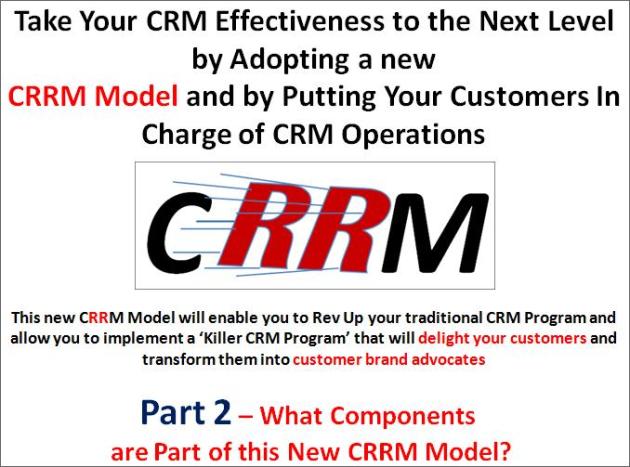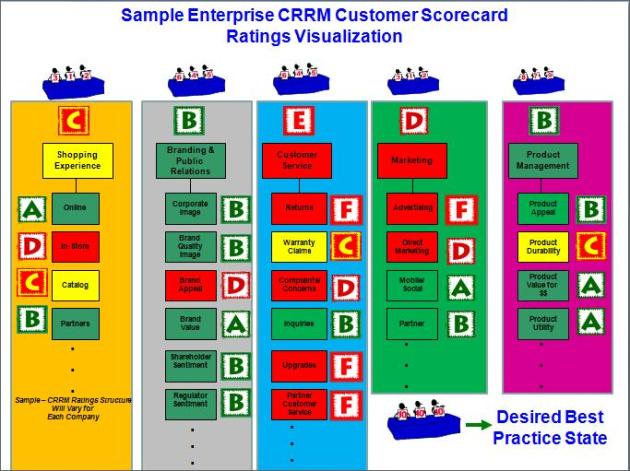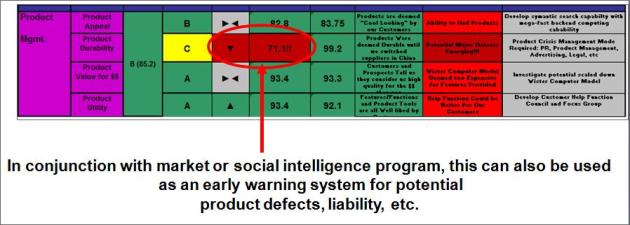Blow Away Your Competition by Replacing Your Old CRM Program with the New Customer Relevant Relationship Management (CRRM) Model – Part 2: The Necessary Components.
March 18, 2012 4 Comments
1) Introduction:
In my previous blog, I covered what the new Customer Relevant Relationship Model (CRRM) is and the benefits of adopting this new model. In this blog, I will cover the components of the new CRRM model and what you need to put in place to make this new model a reality.
Ever wonder why companies like ESPN, Apple, Google, Zynga, Amazon, and Marriott dominate their respective markets? The reason is that they are ‘Customer First’ organizations and are passionate about listening to, understanding and then delighting their customers based on leveraging true customer insights. They treat their customers as business partners vs. commodities and include them in many critical decision making processes. They get this new CRRM model. Why/how ? – Read the rest of this blog to find out…
The differences between the old CRM model and how these companies are embracing the newer CRRM model are depicted in the following chart:
2) Customers are fed up with old Dictatorial Management Style & Want to be Empowered as Business Partners
Customers and stakeholders today are longing for a company to partner with them and include them in the corporate decision making process. These same constituencies are sick and tired of political, corporate, and other organizations making unilateral decisions for them that are really not in-line with their needs, wants, etc. The backlash from this unwanted dictatorial management style of some companies can be seen in the Bank of America fee customer rebellion, the customer backlash from Netflix deciding to split their company without first consulting with their customers and HPs initial decision to exit the computer market.
3) Components of the New CRRM Model:
In order to progress your organization from the old CRM model to the new CRRM model, a few key essentials must be put in place and are as follows:
A. New CRRM Model that includes the 360° Cultivation of Customer & Market Insights. This model enables a 360° view of all customer and market insights including customer feedback, preferences, likes, dislikes, social sentiment, competitor activity, etc. This new model takes your insights to an entirely new level whereby you are now enabled to delight customers, stakeholders and stockholders by having insights that are light-years ahead of insights provided by a traditional CRM model.
B. Customer First Culture driven by management that is passionate about their customers including a set of customer first principles and guidelines developed by company leaders
C. Customer Ratings & Feedback Structure that will identify areas where you will collect customer 360° feedback from customer and stakeholder interactions
D. Customer Feedback & Preferences Cultivation Process and corresponding infrastructure in order to allow your customers to continually rate how well you are serving them
E. Customer Health Scorecard that provides real-time insights on how well the customers, stakeholders and stockholders perceives you as serving them as well as insights into a Continuous Customer Improvement Process (CCIP) that enables you to continually improve your customer perceptions, satisfaction, brand loyalty, etc.
These components can apply to large enterprises as well as Small to Medium Businesses (SMBs).
3A) The above chart “New CRRM Model – 360 Cultivation of Customer & Market Insights” demonstrates the new insights model that must be put in place to deliver world-class stakeholder and customer programs.
These enhanced insights will enable you to deliver products and services that delight your customers, stakeholders and stockholders as well as enable you to leapfrog the competition in terms of market share if they continue to rely on their antiquated CRM data and analytics insights only model.
For Small to Medium sized Businesses (SMBs), some of the insights do not apply, but the following charts (3B-3E) most certainly apply and can be tracked via simple Microsoft Excel spreadsheets.
3B) The above chart “CRRM Organizational Guiding Principles” demonstrates the principles that must be in-place to be customer first culture. This culture is driven by management that is passionate about their customers and governs the company around a set of customer first policies.
3C) The above chart “Enterprise CRRM Customer Rating & Feedback Structure” illustrates a sample structure (will vary for each type of business) whereby customer feedback and preferences will be cultivated in order to develop 360° insights into customer needs, wants, likes, etc.
3D) The above chart “CRRM Customer Ratings & Feedback Cultivation Process” illustrates a how customer feedback and preferences will be cultivated in order to develop 360° insights into customer needs, wants, likes, etc.
3E) The above chart “Enterprise CRRM Customer Scorecard Ratings Visualization” illustrates a how customer feedback and preferences ratings will be visually represented in a scorecard.
3E-2) The above chart “Enterprise CRRM Customer Scorecard” illustrates a how customer feedback and preferences ratings will be rolled up into an analytical scorecard that provides insights into customer trends, customer feedback, customer issues, core customer strengths and weaknesses, etc.
This scorecard can also be used to manage a Continuous Customer Improvement Process (CCIP) that continually drives improvements to customer perceptions, ratings, satisfaction, etc.
The above depicts how analytics and metrics would be maintained for a business who had a retail or wholesale shopping function.
Robust Scorecard Analytics and Metrics should support Customer Trend Identification and Root Cause Analysis for Customer Issues.
Sample Public Relations Scorecard Above gives you insights into how well your company and brands are perceived by customers, stakeholders, stockholders, etc.
Sample Customer Scorecard Above from Customer Service tells how well you are serving your customers.
Sample Marketing Scorecard Above Gives you insights into how well your Marketing Efforts are resonating with your customers.
The Sample Product Management Scorecard above gives you insights into how well perceived your products and services are with customers and prospects.
4) Company & Customer Benefits of Adopting the CRRM Model:
By treating customers as business partners (vs. commodities) and including them in the corporate decision making process, as well as allowing them to rate how well you are serving them from an array of customer facing areas, companies can reap huge rewards including the following:
1. Better insights into the types of products and services customers want & need
2. Fiercely loyal customers who feel part of the corporate team
3. Customers who are most likely to spend more, be retained longer and purchase at premium prices with higher profit margins
4. Customers who are very likely to be brand advocates and refer others to your company, brands, and services.
5. Customers who feel connected to the company and empowered to improve company operations
The following are actual customer comments from those who have participated in a customer feedback program to help shape products & services:
“I feel like xyz company cares about me since they ask my opinion”
“Finally a company that listens to us”
“It is so refreshing to have a company ask you your opinions on products and services vs. ramming something down our throats that we don’t like”
“Wow – this is fun. I enjoy providing my opinion”
“As silly as this might sound, xyz company is the only company that ever asked me what I wanted”
“In my opinion, xyz company is much more progressive than their competitors by seeking consumer opinions, what matters to them, etc.
5) Conclusion:
More dynamic companies like Goodle, Zynga, Amazon, etc. are inviting customers to become part of the corporate decision making process and empowering them to provide feedback, insights and rate company operations in order to drive continous customer improvements. Companies who adopt this new CRRM model whereby company management is democratized by including stakeholders and customers into the decision making process will reap the rewards of ever higher customer acquisition, retention and spend – leading to ever higher profits and share price.














